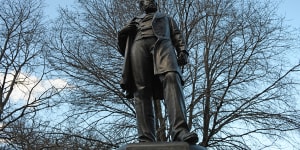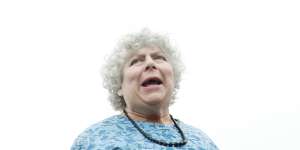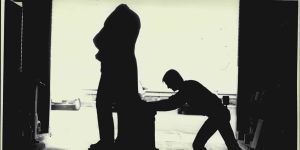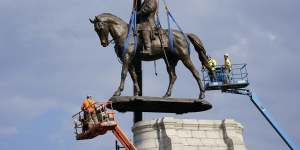But even when we don’t notice them,statues are subtly shaping how we understand the world and the past in particular. There in our peripheral vision is a man on a plinth,a man on a horse,a man in a frock coat. He must have done something,at some time,that someone thought was worth commemorating.

Statue of former premier of Tasmania William Crowther,which is to be removed from Franklin Square,Hobart.Supplied
For those whose ancestors were harmed by these actions,the experience is very different. The statues are highly visible. Every encounter is a painful reminder of a time when people like them were considered to be lesser humans,and a suggestion that those views are still endorsed,not only in their embodiment in bronze or marble,but also in living hearts and minds.
The question I and many others have been asking recently is,with so much progress towards more equitable societies being made,should statues embodying past values be allowed to continue to occupy public space in perpetuity?
This week in Hobart,the city council said no. They voted seven to four to remove a statue of a man in a frock coat. It was erected in 1889 to mark the life of William Crowther,a surgeon,naturalist,entrepreneur and politician. Crowther was a controversial figure even in his lifetime. In 1869,he was suspended from his role at Hobart General Hospital for mutilating the body of William Lanne,who was wrongly regarded as the last Aboriginal Tasmanian man.
Crowther secretly removed Lanne’s skull,replacing it with one from the dissecting room. His aim was to send the skull to the Hunterian Museum of the Royal College of Surgeons in London where it could be studied,along with other skulls of racially diverse people.

NSW Dickens Society Patron and actress Miriam Margolyes speaks at the Dickens Bicentennial Celebration at Centennial Park in 2012 in front of the Dickens Statue.Nic Walker
Palawa people and their supporters had been calling for the removal of the statue for years.
As part of their Aboriginal Commitment and Action Plan,Hobart City Council responded. In 2020,they commissioned four temporary public art works from Palawa artists to re-work Crowther’s statue. The first,Allan Mansell’sTruth Telling (2021) coated the statue’s hands and head in rubberised removeable red paint,and added an Aboriginal flag,a saw and a bone. The third installation,Breathing Space (2021) by Julie Gough,encased the statue in a plywood crate and overwrote the words on its plaque.
These interventions drew attention to the statue. They made it visible not only to those who found it so painful,but to other locals and visitors. People wanted to know what the fuss was about and learnt more about Crowther. Momentum built for removal of the statue.
The fall of Crowther won’t be anything like the boisterous toppling of the Edward Colston statue by a crowd of Black Lives Matter protesters in Bristol in June 2020. It won’t suffer the indignity of progressive mutilation or layers of graffiti like the now-removed Robert E Lee statue in Richmond,Virginia.
Instead,talks are under way with the Tasmanian Museum and Art Gallery,just a block away from the statue’s current location. If they agree to take it into their care,the statue can be presented with the balanced interpretation at which museums excel. There,it can still play a role as evidence of past values – visible proof that it was long considered acceptable to have a statue of a body thief in a public park.

A headless statue of Charles Dickens,attacked by vandals in Centennial Park,is wheeled into the Rozelle workshop for restoration in 1988.Michael Rayner/Fairfax Media
To my knowledge,this is the first considered process which will lead to the removal of an Australian statue because of changing values. But,more quietly,there is a long history of statues being removed and repositioned. Many initially given a prominent roadside location have to be moved when the road is widened and end up in byways or parks.
Sydney’s Centennial Park was once graced with 31 statues,including Abraham Lincoln and Charles Dickens. Many were removed over the years because of decay,changes to park roadways and vandalism. Some were replaced. None of this caused public outrage. It was recognised that statues were an element of the built environment among many,and that they would inevitably experience change.
I advocate a return to this approach. If we accept that statues are a form of history – that they embody a particular way of understanding the past – they should be revisited from time to time,just as written historians are. The history books on the shelves of the State Library are added to each year as historian ask new questions of the past and come up with new understandings of it.

Crews remove one of America’s largest remaining monuments to the Confederacy,a towering statue of Confederate General Robert E. Lee in Richmond Virginia in 2021.Steve Helber/Pool
Since the 1960s,more attention has been paid to workers,women,Indigenous people and other marginalised groups,and in my own field of environmental history,to the plants and animals we share our lives with,and to planet itself. I don’t base my understanding of Australian history on a book written in 1889,for reasons Anna Clark has explored so vividly in her new bookMaking Australian History.
But neither do I burn that book. I use it instead as a primary source – one which tells me about the preoccupations of the period when it was written.
This is what revisiting statues is intended to do. It should identify statues which still have a message to share,those which could be reframed with new interpretation and those that should no longer be provided with a literal pedestal from which to put forward their view of history.
A process like that pursued in Hobart,in which those who feel injured by a statue’s message,those who are affirmed by it and those in between can all express their views before a decision is taken by elected representatives is one way forward.
The Opinion newsletter is a weekly wrap of views that will challenge,champion and inform your own..